Rotterdam
| Rotterdam | |||
|---|---|---|---|
| — Municipality / City — | |||
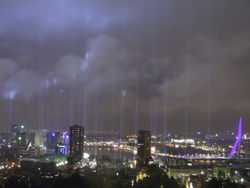 |
|||
|
|||
| Nickname(s): Rotjeknor, Manhattan aan de Maas, Roffa | |||
| Motto: Sterker door strijd (Stronger through struggle) | |||
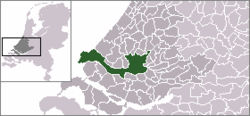 |
|||
| Coordinates: | |||
| Country | Netherlands | ||
| Province | Zuid-Holland | ||
| Government | |||
| - Mayor | Ahmed Aboutaleb | ||
| - Aldermen | Lucas Bolsius Leonard Geluk Rik Grashoff Hamit Karakus Jantine Kriens Peter Lamers Dominic Schrijer Hans Vervat |
||
| Area[1] | |||
| - Municipality / City | 319 km2 (123.2 sq mi) | ||
| - Land | 206 km2 (79.5 sq mi) | ||
| - Water | 113 km2 (43.6 sq mi) | ||
| Population (18 March 2010)[1][2] | |||
| - Municipality / City | 603 425 | ||
| - Density | 2,850/km2 (7,381.5/sq mi) | ||
| - Metro | Approx. 1.6 million | ||
| - Demonym | Rotterdammer | ||
| Time zone | CET (UTC+1) | ||
| - Summer (DST) | CEST (UTC+2) | ||
| Area code(s) | 010 | ||
| Website | www.rotterdam.nl | ||
Rotterdam (pronounced /ˈrɒtərdæm/; Dutch [rɔtərˈdɑm]) is a city and municipality in the Dutch province of South Holland, situated in the west of the Netherlands. The municipality is the second largest in the country, with a population of 603,425 as of March 2010.
The greater Rotterdam area, best known as 'Rotterdam-Rijnmond'/'Rijnmond region' (Rijnmond is to be literally translated as "the Rhine's mouth", referring to Rotterdam's location at the end of the Rhine-delta and its economic position as Europe's main port) contains around 1.3 million people (by some standards it rather approaches 2 million inhabitants). It forms the southern part of the Randstad, the sixth-largest metropolitan area in Europe, with a population of 6.7 million.
The port of Rotterdam is the largest in Europe. From 1962 to 2004 it was the world's busiest port until surpassed by Shanghai. Rotterdam is on the banks of the river Nieuwe Maas ('New Meuse'), one of the channels in the delta formed by the Rhine and Meuse rivers. The name Rotterdam derives from a dam in the Rotte river.
Contents |
Municipality
On 1 January 2007 (source: Statistics Netherlands), the municipality covered an area of 319 km2 (206.44 km2 of which is land) with a population of 584,046. It is part of a larger metropolitan area with a total population (including Dordrecht and surrounding cities) of approximately 1.6 million. In 1965, the municipal population of Rotterdam reached its peak of 731,000, but by 1984 it had decreased to 555,000 as a result of suburbanization.
Rotterdam consists of 12 submunicipalities: Charlois (including Heijplaat), Delfshaven, Feijenoord, Hillegersberg-Schiebroek, Hoek van Holland, Hoogvliet, IJsselmonde, Kralingen-Crooswijk, Noord, Overschie, Prins Alexander (the most populous submunicipality with around 85,000 inhabitants), and Rozenburg. Two other areas, Centrum ('Center') and Pernis, do not have official submunicipality status.
Rotterdam is in the Zuidvleugel ('South Wing') of the Randstad ('Rim City') conurbation, with 6.7 million inhabitants, the sixth largest metropolitan area in Europe (after Moscow, London, the Ruhr Area, Istanbul, and Paris). The Zuidvleugel includes Leiden, The Hague, Zoetermeer, Delft, Vlaardingen, Schiedam, Capelle aan den IJssel, Spijkenisse and Dordrecht, and has a population of around 3 million.
Municipal additions
The current size of the municipality of Rotterdam is the result of the amalgamation of the following former municipalities,[3] some of which now are a submunicipality:
- Delfshaven (added on 30 January 1886)
- Charlois (added on 28 February 1895)
- Kralingen (added on 28 February 1895)
- Hoogvliet (added on 1 May 1934)
- Pernis (added on 1 May 1934)
- Hillegersberg (added on 1 August 1941)
- IJsselmonde (added on 1 August 1941)
- Overschie (added on 1 August 1941)
- Schiebroek (added on 1 August 1941)
- Rozenburg (added on 18 March 2010)
History
- For the destruction of the city center in 1940, see Bombing of Rotterdam
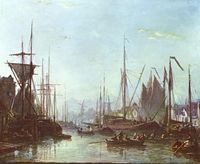
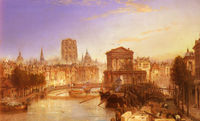
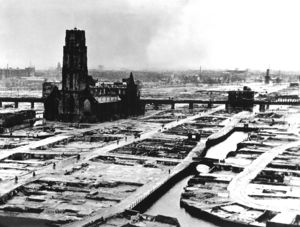
Settlement at the lower end of the fen stream Rotte (or Rotta, as it was then known, from rot, 'muddy' and a, 'water', thus 'muddy water') dates from at least 900 CE. Around 1150, large floods in the area ended development, leading to the construction of protective dikes and dams, including Schielands Hoge Zeedijk ('Schieland’s High Sea Dike') along the northern banks of the present-day Nieuwe Maas. A dam on the Rotte or 'Rotterdam' was built in the 1260s and was located at the present-day Hoogstraat ('High Street').
On 7 June 1340, Count Willem IV of Holland granted city rights to Rotterdam, which then had approximately 2000 inhabitants. Around 1350 a shipping canal, the Rotterdamse Schie was completed, which provided Rotterdam access to the larger towns in the north, allowing it to become a local transshipment center between Holland, England and Germany, and to urbanize.
The port of Rotterdam grew slowly but steadily into a port of importance, becoming the seat of one of the six 'chambers' of the Vereenigde Oostindische Compagnie (VOC), the Dutch East India Company.
The greatest spurt of growth, both in port activity and population, followed the completion of the Nieuwe Waterweg in 1872. The city and harbor started to expand on the south bank of the river. The Witte Huis or White House skyscraper,[4] inspired by American office buildings and built in 1898 in the French Chateau-style, is evidence of Rotterdam's rapid growth and success. When completed, it was the tallest office building in Europe, with a height of 45 m (147.64 ft).
During World War II, the German army invaded the Netherlands on 10 May 1940. Adolf Hitler had hoped to conquer the country in just one day, but his forces met unexpectedly fierce resistance. The Dutch army was finally forced to capitulate on 14 May 1940, following Hitler's bombing Rotterdam and threatening to bomb other Dutch cities. The heart of Rotterdam was almost completely destroyed by the Luftwaffe; 900 civilians were killed and 80,000 made homeless. The City Hall survived the bombing. Ossip Zadkine later strikingly captured the event with his statue Stad zonder hart ('City without a heart'). The statue stands near the Leuvehaven, not far from the Erasmusbrug in the centre of the city, on the north shore of the river Nieuwe Maas.
Rotterdam was gradually rebuilt from the 1950s through the 1970s. It remained quite windy and open until the city councils from the 1980s on began developing an active architectural policy. Daring and new styles of apartments, office buildings and recreation facilities resulted in a more 'livable' city center with a new skyline. In the 1990s, the Kop van Zuid was built on the south bank of the river as a new business center.
Demographics
Overall the demographics differ per city area. According to a recent area analysis city centre has a singles population of 70%, between the age of 20 and 40, considerably more than other city areas. Also the city centre has a much larger population of people with higher education and higher income. Nonetheless 80% of the homes are rented not owned. City centre also has a higher percentage (51% vs 45%) of foreigh born citizens (Dutch: Allochtonen). The majority (70%) of shops is also run by foreign born citizens.[5]
Ethnic make-up
Figures are from 2008:
- Total: 582,949
- Dutch: 313,765
- Surinamese: 51,885
- Turkish: 45,699
- Moroccan: 37,476
- Antillean / Aruban: 19,562
- South-European: 17,77
In the Netherlands, Rotterdam has the highest percentage of foreigners from non-industrialised nations. They form a large part of Rotterdam's multi ethnic and multicultural diversity. Nearly 50% of the population are of non Dutch origins or have at least one parent born outside the country. Recent figures show that Muslims comprise close to 25% of the city's population.[6] The current mayor of Rotterdam, Ahmed Aboutaleb, is of Moroccan descent and is a practicing Muslim. The city is home to the largest Dutch Antillean community. The city also has its own China Town at the (West-) Kruiskade, close to the central railway station.
Historical population
- 1796: 53,200 inhabitants
- 1830: 72,300
- 1849: 90,100
- 1879: 148,100
- 1899: 318,500
- 1925: 547,900
- 1965: 551,000
- 1984: 555,000
- 2005: 596,407
- 2006: 588,576
- 2007: 584,046
- 2010: 603,425
Geography
.png)

Rotterdam is divided into a northern and a southern part by the river Nieuwe Maas, connected by (from west to east): the Beneluxtunnel; the Maastunnel; the Erasmusbrug ('Erasmus Bridge'); a subway tunnel; the Willemsspoortunnel ('Willems railway tunnel'); the Willemsbrug ('Willems Bridge'); the Koninginnebrug ('Queen's Bridge'); and the Van Brienenoordbrug ('Van Brienenoord Bridge'). The former railway lift bridge De Hef ('the Lift') is preserved as a monument in lifted position between the Noordereiland ('North Island') and the south of Rotterdam.
The city centre is located on the northern bank of the Nieuwe Maas, although recent urban development has extended the center to parts of southern Rotterdam known as De Kop van Zuid ('the Head of South', i.e. the northern part of southern Rotterdam). From its inland core, Rotterdam reaches the North Sea by a swathe of predominantly harbor area.
Built mostly behind dikes, large parts of the Rotterdam are below sea level. For instance, the Prins Alexander Polder in the northeast of Rotterdam extends 6 meters below sea level, or rather below Normaal Amsterdams Peil (NAP) or 'Amsterdam Ordnance Datum'. The lowest point in the Netherlands (6.76 meters (22 ft) below NAP) is situated just to the east of Rotterdam, in the municipality of Nieuwerkerk aan den IJssel.
The Rotte river no longer joins the Nieuwe Maas directly. Since the early 1980s, when the construction of Rotterdam’s second subway line interfered with the Rotte’s course, its waters have been pumped through a pipe into the Nieuwe Maas via the Boerengat.
Commerce and industry
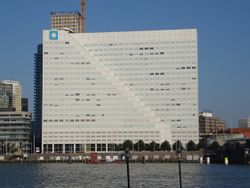
Rotterdam has always been one of the main centers of the shipping industry in the Netherlands. From the Rotterdam Chamber of the VOC, the worlds first multinational, established in 1602, to the merchant shipping leader Royal Nedlloyd established in 1970, with its corporate head quarters located in the landmark building the 'Willemswerf' in 1988. In 1997 Nedlloyd merged with the British shipping industry leader P&O forming the third largest merchant shipping company in the world. The anglo-Dutch P&O Nedlloyd was bought by the Danish giant corporation 'AP Moller Maersk' in 2005 and its Dutch operations are still head quartered in the 'Willemswerf'. Rotterdam is also home to the Dutch half of the anglo-Dutch consumer goods giant Unilever, and Mittal Steel Company N.V., subsidiary of Luxembourg-based Arcelor Mittal, the world's largest steel company.
The Erasmus University has a strong focus on research and education in management and economics. The University is located on the east side of the city and is surrounded by numerous multinational firms. On Brainpark I, Brainpark II, Brainpark III and Het Rivium are located offices of major multinationals. In the center of the city are the above-mentioned Unilever offices, but also Robeco, Fortis (including Mees Pierson and Stad Rotterdam Verzekeringen), ABN AMRO, ING (Nationale Nederlanden), the Rotterdam WTC, and the before mentioned Maersk Line who incorporates the Dutch merchant marine legacy.
Ports
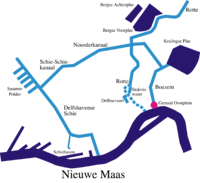
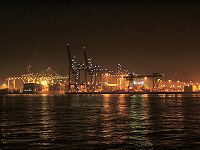
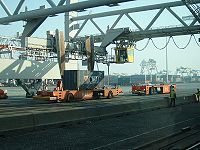
Rotterdam has the largest port in Europe, with the rivers Meuse and Rhine providing excellent access to the hinterland upstream reaching to Basel, Switzerland and into France. In 2004 Shanghai took over as the world's busiest port. In 2006, Rotterdam was the world's seventh largest container port in terms of Twenty-foot equivalent units (TEU) handled.[7]
The port's main activities are petrochemical industries and general cargo handling and transshipment. The harbour functions as an important transit point for bulk materials and between the European continent and overseas. From Rotterdam goods are transported by ship, river barge, train or road. In 2007, the Betuweroute, a new fast freight railway from Rotterdam to Germany, was completed.
In 1872, the Nieuwe Waterweg ('New Waterway') opened, a ship canal constructed to keep the city and port of Rotterdam accessible to seafaring vessels as the natural Meuse-Rhine channels silted up. The canal proper measures approximately 6.5 kilometers (4 mi) from the western tips of its protruding dams to the Maeslantkering ('Maeslant Barrier'). Many maps, however, include the Scheur as part of the Nieuwe Waterweg, leading to a length of approximately 19.5 kilometers (12 mi).
In the first half of the twentieth century, the port's center of gravity shifted westward towards the North Sea. Covering 105 square kilometers (40.5 sq mi), the port of Rotterdam now stretches over a distance of 40 kilometers (25 mi). It consists of the city center's historic harbor area, including Delfshaven; the Maashaven/Rijnhaven/Feijenoord complex; the harbors around Nieuw-Mathenesse; Waalhaven; Vondelingenplaat; Eemhaven; Botlek; Europoort, situated along the Calandkanaal, Nieuwe Waterweg and Scheur (the latter two being continuations of the Nieuwe Maas); and the reclaimed Maasvlakte area, which projects into the North Sea.
The construction of a second Maasvlakte received initial political approval in 2004, but was stopped by the Raad van State (the Dutch Council of State, which advises the government and parliament on legislation and governance) in 2005, because the plans did not take enough account of environmental issues. On 10 October 2006, however, approval was acquired to start construction in 2008, aiming for the first ship to anchor in 2013.
Education
Rotterdam has one major university, the Erasmus University Rotterdam (EUR), named after one of the city's famous former inhabitants, Desiderius Erasmus. The Woudestein campus houses (among others) the Rotterdam School of Management. In Financial Times' 2005 rankings it placed 29th globally and 7th in Europe. In the 2006 rankings of European Masters of Management, the school reached a second place with the CEMS Master in Management and a thirteenth place with its RSM Master in Management. The university is also home to Europe's largest student association, STAR Study Association RSM Erasmus University and the world's largest student association, AIESEC, has its international office in the city.
The Willem de Kooning Academy Rotterdam's main art school, which is part of the Hogeschool Rotterdam. It is regarded as one of the most prestigious art schools in the Netherlands and the number 1 in Advertising and Copywriting. Part of the Willem de Kooning Academy is the Piet Zwart Institute for postgraduate studies and research in Fine Art, Media Design and Retail Design. The Piet Zwart Institute boasts a selective roster of emerging international artists.
The Hoboken campus of EUR houses the Dijkzigt (general) hospital, the Sophia Hospital (for children) and the Medical Department of the University. These are known collectively as the Erasmus Medical Center, which is ranked third worldwide for medical research, behind the Harvard University and Johns Hopkins University. The Erasmus Medical Center ranks as the top European institution in clinical medicine[8] according to the Times Higher Education rankings. As a combined medical treatment and research center it is particularly noted for its patient cohort studies in which large numbers of patients are followed for long periods of time.
There are also three Hogescholen (Universities of applied sciences) in Rotterdam. These schools award their students a professional Bachelor's degree and postgraduate or Master's degree. The three Hogescholen are Hogeschool Rotterdam, Hogeschool INHOLLAND and Hogeschool voor Muziek en Dans (uni for music and dance) which is also known as CodArts.
Culture
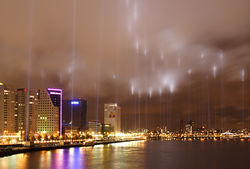
Alongside Porto, Rotterdam was European Capital of Culture in 2001. The city has its own orchestra, the Rotterdam Philharmonic Orchestra with its world famous musical director Yannick Nézet-Séguin, a large congress and concert building called De Doelen, plus many theatres (including the new Luxor theatre) and movie theatres. The Ahoy complex in the south of the city is used for pop concerts, exhibitions, tennis tournaments and other activities. A major zoo called Diergaarde Blijdorp is situated at the northwest side of Rotterdam, complete with a walkthrough sea aquarium called the Oceanium.
The city is home to the Willem de Kooning Academy and Piet Zwart Institute.
Rotterdam is currently going through somewhat of a renaissance, with some urban renewal projects featuring ambitious architecture, an increasingly sparkling nightlife, and a host of summer festivals celebrating the city's multicultural population and identity, such as the Caribbean-inspired 'Summer Carnival', the Dance Parade, Rotterdam 666, the Metropolis pop festival and the World Harbor days. The city has a few venues for pop music like Rotown, WATT, Exit. The venue WORM focuses on experimental music and related cutting edge subcultural music. There are also the International Film Festival in January, the Poetry International Festival in June, the North Sea Jazz Festival in July, the Valery Gergiev Festival in September, September in Rotterdam and the World of the Witte de With. In June 1970, The Holland Pop Festival (which featured Jefferson Airplane, The Byrds, Canned Heat, It's a Beautiful Day, and Santana) was held and filmed at the Stamping Grounds in Rotterdam.
The self-image of the city is that of a no-nonsense workers' city. In that sense, there is a healthy competition with Amsterdam, which is often viewed as the cultural capital of the Netherlands. There is a saying: "Amsterdam to party, Den Haag (The Hague) to live, Rotterdam to work". Another one, more popular by Rotterdammers, is "Money is earned in Rotterdam, divided in The Hague and spent in Amsterdam". Another saying that reflects both the rivalry between Rotterdam and Amsterdam is "Amsterdam has it, Rotterdam doesn't need it".
Rotterdam has had a rich hiphop music scene since the early 1980s. It is also the home of Gabber, a type of hardcore electronic music popular in the mid-1990s, with hard beats and samples. Groups like Neophyte and Rotterdam Terror Corps (RTC) started in Rotterdam.
The main cultural organisations in Amsterdam, such as the Concertgebouw and Holland Festival, have joint forces with similar organisations in Rotterdam, via A'R'dam. In 2007 these organisations published with plans for co-operation.[9] One of the goals is to strengthen the international position of culture and art in the Netherlands in the international context.
Museums
Rotterdam has many museums. Well known museums are the Boijmans-van Beuningen Museum, the NAi (Netherlands Architecture Institute), the Volkenkundig Museum (foreign peoples and cultures), the Kunsthal (design by Rem Koolhaas),the center for contemporary art Witte de With,[10] the Maritiem Museum[11] and the Brandweermuseum (Fire brigade museum). The Historisch Museum [1](Historical museum) has two buildings: the Dubbelde Palmboom and the Schielandshuis. Other museums include the tax museum and the nature historical museum. At the historical shipyard and museum Scheepswerf 'De Delft the reconstruction of Ship of the Line 'De Delft' can be visited.[12]
Architecture and skyline
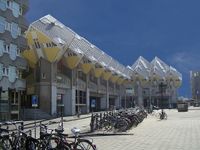
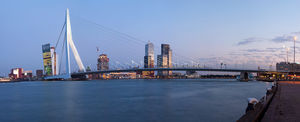
In 1898, the 45 meter high-rise office building the White House (or in official Dutch Witte Huis) was completed, at that time the tallest office building in Europe. In the first decades of the 20th century, some influential architecture in the modern style was built in Rotterdam. Notable are the Van Nelle fabriek (1929) a monument of modern factory design by Brinkman en Van der Vlugt, the Jugendstil clubhouse of the Royal Maas Yacht Club designed by Hooijkaas jr. en Brinkman (1909), and Feyenoord's football stadium de Kuip (1936) also by Brinkman en Van der Vlugt. The architect J. J. P. Oud was a famous Rotterdammer in those days. During the early stages of World War II the center of Rotterdam was bombed by the Germans, destroying many of the older buildings in the center of the city. After initial crisis re-construction the center of Rotterdam has become the site of ambitious new architecture.
Rotterdam is also famous for its Kubuswoningen or cube houses built by architect Piet Blom in 1984. In addition to that there are many international well known architects based in Rotterdam like O.M.A (Rem Koolhaas), MVRDV, Neutelings & Riedijk and Erick van Egeraat to name a few.
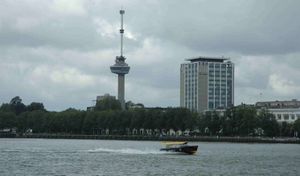
Rotterdam houses several of the tallest structures in the Netherlands.
- The Erasmus Bridge (1996) is a 790-meter (2,600 ft) cable stayed bridge linking the north and south of Rotterdam. It is held up by a 138 meters (453 ft) tall pylon with a characteristic bend, earning the bridge its nickname 'De Zwaan' ('the Swan').
- Rotterdam has the tallest residential building in the Netherlands: the Montevideo Tower (160 m (524 ft)).
- Rotterdam is also home to the tallest office building 'Maastoren' (164.75 m (540.5 ft)) which houses Deloitte. This office tower surpassed the 'Delftse Poort' (160 m (520 ft)) which houses Nationale-Nederlanden insurance company, part of ING Group as tallest office tower in 2009.[13][14][15]
- The city also houses the 186 meters (610 ft) tall Euromast, which has long been a major tourist attraction. It was built in 1960, initially reaching a height of 101 meters (331 ft); in 1970, the Euromast was extended by 85 meters (279 ft) to its current height.
Rotterdam has a reputation in being a platform for architectural development and education through the Berlage Institute, a postgraduate laboratory of architecture, and the NAi (Netherlands Architecture Institute), which is open to the public and has a variety of good exhibitions on architecture and urban planning issues.
Rotterdam is standing in the best European SkylineTop together with Frankfurt, London, Madrid, Paris, Brussels, Moscow, and Warsaw. Over 30 new highrise projects are being developed at the moment, including the 165 meters (541 ft) high 'Maas Tower', the 'New Orleans Tower', which will be about 158 meters (518 ft) and the Zalmhaven Urban Tower 212 meters (696 ft).[16]
Sports
Rotterdam is the home of three professional football clubs; two Eredivisie ('Honorary Division', or Dutch Premier League) football clubs, Feyenoord and Excelsior, and one Eerste Divisie club, Sparta. Rotterdam also has three Hoofdklasse (main class) clubs, SC Feijenoord (Feyenoord Amateurs), PVV DOTO and TOGR.
Feyenoord, founded in 1908 and the dominant of the three professional clubs, has won fourteen national titles since the introduction of professional football in the Netherlands. It won the European Cup as the first Dutch club in 1970, and won the World Cup for club teams in the same year. In 1974, they were the first Dutch club to win the UEFA Cup and in 2002, Feyenoord won the UEFA Cup again. In 2008, the year of their 100-year-anniversary, Feyenoord won the KNVB-cup. Feyenoord also has the biggest supporter group in the Netherlands.
Seating 51,480, its 1931 stadium, called Stadion Feyenoord but popularly known as De Kuip ('the Tub'), is the second largest in the country, after the Amsterdam ArenA. De Kuip, located in the southeast of the city, has hosted many international football games, including the final of Euro 2000 and has been awarded a FIFA 5 star ranking. There are concrete plans to build a new stadium with a capacity of at least 80,000 seats. If the football worldchampionship in 2018 will go to the Netherlands and Belgium, the stadium is supposed to host the final of the tournament.
Sparta, founded in 1888 and situated in the northwest of Rotterdam, won the national title six times; Excelsior (founded 1902), in the northeast, has never won any. Nowadays Rotterdam is the only city with two (and with Excelsior sometimes even three) teams in the Eredivisie.
Rotterdam has its own annual international marathon, which offers one of the fastest courses in the world. From 1985 until 1998, the world record was set in Rotterdam, first by Carlos Lopes and later in 1988 by Belayneh Dinsamo. The marathon starts and ends on the Coolsingel in the heart of Rotterdam.
Since 1972, Rotterdam hosts the ABN AMRO World Tennis Tournament, part of the ATP Tour.
Members of the student rowing club Skadi were part of the 'Holland Acht', winning a gold medal at the Olympics in 1996.
In field hockey, Rotterdam has the largest hockey club in the Netherlands, HC Rotterdam, with its own stadium in the north of the city and nearly 2,400 members. The first men's and women's teams both play on the highest level in the Dutch Hoofdklasse.
Rotterdam is home to the most successful European baseball team, Neptunus Rotterdam, winning the most European Cups.
Since 1986, the city has selected its best sportsman, woman and team at the Rotterdam Sports Awards Election, held in December.
Motor cycle speedway was staged in the Feyenoord Stadium after the second world war. The team which raced in a Dutch league was known as the Feyenoord Tigers. The team included Dutch riders and some English and Australian riders.
Tour De France
In November 2008 Rotterdam was chosen as the host of the Grand Départ of the 2010 Tour de France. Rotterdam won the selection over the Dutch city of Utrecht. Germany's Düsseldorf had previously also expressed interest in hosting. The Amaury Sport Organization (ASO), organizer of the Tour de France, said in a statement on its web site that it chose Rotterdam because, in addition to it being another big city, like London, to showcase the use of bikes for urban transportation, it provided a location well positioned considering the rest of the route envisioned for the 2010 event.
The start in Rotterdam was the fifth in the Netherlands. The prologue was a 7 km (4.35 mi) individual time trial crossing the centre of the city. The first regular stage left the Erasmusbrug and went south, towards Brussels.
Shopping
Well-known streets in Rotterdam are the shopping center the Lijnbaan (the first set of pedestrian streets of the country, opened in 1953), the Hoogstraat, the Coolsingel with the city hall, and the Weena, which runs from the Central Station to the Hofplein (square). A modern shopping venue is the Beurstraverse ('Stock Exchange Traverse), better known by the informal name 'Koopgoot' ('Buying/Shopping Gutter', after its low-lying position, crossing Rotterdam's main street Coolsingel below street level).
The main shopping venue in the south of Rotterdam is Zuidplein, which lies close to Ahoy' Rotterdam, an accommodation center for shows, exhibitions, sporting events, concerts and congresses. Another prominent shopping center, called Alexandrium (sometimes still called by its former name Oosterhof), lies in the east of Rotterdam. It includes a large kitchen and furniture center.
Yearly events
- January: International Film Festival Rotterdam[17]
- April–June
- Rotterdam Marathon[18]
- August:
- Bavaria City Race
- Pleinbioscoop[19]
- June till September: the Rotterdam Summer festivals, including
- September:
- World Port Days (2006: 1, 2 and 3 September)[22]
Transportation
Rotterdam is well connected in international, national, regional and local public transport systems, as well as by the Dutch motorway system.
Motorways
There are several motorways which run to/from Rotterdam. The following four are part of its 'Ring' (ring road):
- A20 (Ring North): Hoek van Holland – Rotterdam – Gouda
- A16 (Ring East): Rotterdam – Breda (- Belgium – Paris)
- A15 (Ring South): Europoort – Rotterdam – Nijmegen
- A4 (Ring West).
The following two other motorways also serve Rotterdam:
Airport
Much smaller than the international hub Schiphol airport, Rotterdam The Hague Airport (formerly known as Zestienhoven) is the third largest airport in the country. Located north of the city, it has shown a very strong growth over the past five years, mostly caused by the growth of the low-cost carrier market. For business travelers Zestienhoven Airport offers advantages due to rapid handling of passengers and baggage. Environmental regulations make further growth uncertain.
Train
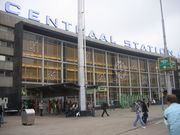
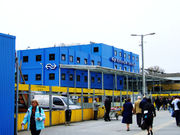
Rotterdam is well connected to the Dutch railroad system, and has several international connections. The train system hosts:
Four trainlines
- South direction Dordrecht-and further (including international to Belgium/France)
- West direction Hoek van Holland
- North-West direction The Hague, Amsterdam
- North-East direction Utrecht
- A fifth alternative train system to the Hague, the Hofplein Line was converted to the light-rail system Randstadrail in 2006.
- The city is often publicized as the terminus of the Eurasian Land Bridge.
Railway stations
- Rotterdam Centraal -Rotterdam's main station
- Rotterdam Alexander – Eastern part of Rotterdam
- Rotterdam Blaak – Close to the centre of Rotterdam
- Rotterdam Lombardijen – Most Southern part of Rotterdam
- Rotterdam Noord – Northern part of Rotterdam
- Rotterdam Zuid –Northern part of the Southern part of Rotterdam
- Rotterdam Stadion – A station near the De Kuip stadium, open in connection with football matches and music concerts
Main connections
- Direct international services to Belgium and France via high speed train system: Thalys
- Frequent international trains to Antwerp and Brussels, Belgium
- Frequent services within the Netherlands:
- Intercity line to The Hague, Leiden, Schiphol airport and Amsterdam (north)
- Intercity line to Utrecht and on to Deventer or Enschede (the east), Leeuwarden (north-west) or Groningen (north-east)
- Intercity line to Dordrecht, Roosendaal and on to Vlissingen (south west)
- Intercity line to Dordrecht, Breda, Tilburg, Eindhoven and Venlo (south east)
- Night services every hour connecting every day of the week to Delft, The Hague, Leiden, Schiphol airport, Amsterdam, and, with a detour, Utrecht. On Thursday, Friday and Saturday night services (either direct or via a detour) to Den Bosch, Eindhoven, Tilburg, Roosendaal.
- Several semi-fast services and local trains originate or call at Rotterdam Centraal; semi-fast services Amsterdam-Breda.
- Detailed information available from the site of the Nederlandse Spoorwegen (Dutch Railways)[23]
In Rotterdam Public Transport services are provided by these company's:
- NS (Dutch Railways) ; Train services
- RET (Rotterdam Elektrische Tram); Tram, city-bus, metro, randstadrail and ferry-services in Rotterdam and surrounding city's.
- Q-buzz (company owned 51% by NS and 49% by KLM) ; Province bus services.
- Arriva Netherlands ; Province bus services.
- Connexxion ; Province bus services.
- Veolia ; Province bus services.
Light rail
To bridge the gap between national train services and local public transportation the Dutch Randstad has developed a regional lightrail system called Randstad Rail. First trains ran in September 2006.
Subway
In 1968 Rotterdam was the first Dutch city to open a subway system. Currently the system consists of two main lines, each of which has some variants.
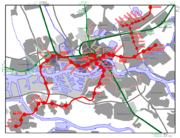
- Erasmus Line: Rotterdam Central station – Albrandswaard (Rhoon, Poortugaal) – Hoogvliet – Spijkenisse
- Caland Line: two lines from the northeast of Rotterdam (Ommoord and since September 2005 to the new constructed neighborhood Nesselande (before it ended at Zevenkamp which is one stop before Nesselande), both in Prins Alexander) and one from Capelle aan den IJssel join; the combined line terminated in the west of Rotterdam, but on 4 November 2002, an extension was opened: the line now connects to the main railway network at Schiedam railway station, has a stop in Pernis and joins the Erasmus Line in Hoogvliet; trains on the Caland Line, like those on the Erasmus Line, terminate in Spijkenisse.
- The eastern parts of the Caland Line have some level crossings (with priority), and could therefore be called light rail instead of metro; however, they are integrated in the system; these parts have overhead wires, while the rest has a third rail, the vehicles can handle both.
Tram
Rotterdam offers 9 regular tramlines and 4 "special" tramlines with a total length of 93.4 kilometers. Service Tramlines in Rotterdam as of 2010:
- 2: (Rotterdam) Charlois – Rotterdam Lombardijen NS – (Rotterdam) Groene Tuin (Drives only at the Southern part of the city)
- 4: (Rotterdam) Molenlaan – Rotterdam CS – (Rotterdam) Marconiplein
- 7: (Rotterdam) Woudestein – Rotterdam CS – (Rotterdam) Willemsplein
- 8: (Rotterdam) Spangen – Rotterdam CS – (Rotterdam) Kleiweg
- 11: Rotterdam CS – Diergaarde Blijdorp (Rotterdam Zoo)
- 20: Rotterdam CS – Rotterdam Lombardijen NS – (Rotterdam) Thialf
- 21: (Schiedam) Woudhoek – Station Schiedam Centrum – Rotterdam CS – (Rotterdam) De Esch
- 23: (Vlaardingen) Holy – Station Schiedam Centrum – Rotterdam CS – (Rotterdam) Beverwaard
- 25: (Rotterdam) Schiebroek – Rotterdam CS – (Barendrecht) Carnisselande
Special tramlines:
- 10: Historical tramline, drives only at summer and throughout the whole city for tourist information. Using historical Rotterdam Trams from the year 1928.
- 29: CS – De Kuip (English:The Tube, Feyenoord stadium) or CS – Het Kasteel (English:The Castle, Sparta Stadium). Football- tramline, drives only at big footballgames at either De Kuip or Het Kasteel.
- Snert-tram: Historical tram, only in winter as an tourist tram to drive through Rotterdam and meanwhile providing people onbourd with a cup of "Snert"; Rotterdamish dialect for the Dutch word: Erwtensoep (English: Pea-soup). Using historical Rotterdam Tram from 1968.
- Ijsjes-tram: Summer-edition to the Snert-tram, providing tourist not with Snert but with ijsjes (English: Ice cream).
Bus
Rotterdam offers 38 City-buslines with a total length of 432.7 kilometers.
RET runs busses in the city of Rotterdam and surrounding places like Spijkenisse, Rhoon, Poortugaal, Schiedam, Vlaardingen, Delft and Cappele a/d. IJssel. Buslines:
- 28, 29, 30, 31, 32, 33, 35, 36, 37, 38, 40, 41, 42, 43, 44, 45, 46, 48, 49, 51, 52, 53, 54, 56, 57, 61, 63, 64, 66, 67, 68, 69, 70, 71, 72, 73, 76, 77, 78, 79, 80 and 89.
Qbuzz runs to places such as Zoetermeer, Berkel & Rodenrijs, Bergschenhoek, Pijnacker and Delft. Buslines:
- 96, 97, 98, 126, 137, 140, 141, 143, 144, 145, 146, 170, 171, 173, 174, 181, 182, 183, 184, 187, 188, 204 and 290.
Arriva Netherlands, Connexxion and Veolia runs busses from other cities to Rotterdam.
Water bus
Every half hour a water bus (Waterbus route 1) goes from Rotterdam to Dordrecht and vice versa. The trip takes an hour, inclusive stops along the way. The ferry can carry about 130 passengers and there is space for 60 bicycles. The stops are:
- Rotterdam Willemskade – Krimpen aan den IJssel Stormpolder – Ridderkerk De Schans – Alblasserdam Kade -Papendrecht Westeind – Hendrik Ido Ambacht Veerweg – Zwijndrecht Veerplein – Dordrecht Merwekade.
Miscellaneous
Beaches
Since the summer of 2003 an artificial beach is created at the Boompjeskade along the Nieuwe Maas, between the Erasmus Bridge and the Willems Bridge. Swimming was not possible, digging pits was limited to the height of the layer of sand, ca. 50 cm. Alternatively people go the beach of Hoek van Holland (which is still a Rotterdam district) or one of the beaches in Zeeland or the Zuid Hollandse Eilanden: Ouddorp, Oostvoorne, Renesse.
Notable Rotterdammers
- Pierre Bayle, enlightenment philosopher.
- Leo Beenhakker, football coach.
- Edsger Dijkstra, Computer Scientist.
- Louis Davids, composer, entertainer, singer.
- Royston Drenthe, Real Madrid C.F. defender/midfielder and Dutch international footballer.
- Francisco Elson, NBA player for the Milwaukee Bucks.
- Desiderius Erasmus, philosopher and humanist.
- Pim Fortuyn, politician, assassinated in 2002.
- Piet Heyn, naval fleet officer.
- Leo Fuld, singer.
- Willem de Kooning, painter.
- Rem Koolhaas, internationally renowned architect.
- Suzanna Lubrano, artist.
- Fatima Moreira de Melo, field hockey player.
- Coen Moulijn, football player of Feyenoord.
- Johan van Oldebarnevelt, statesman of the Dutch Revolt.
- Robin van Persie, Arsenal F.C. forward and Dutch international footballer.
- Marten Toonder, comic writer.
- Abraham Icek Tuschinski, businessman and movie theatre owner.
- Iekeliene Stange, fashion model.
- Hendrik Martensz Sorgh, painter.
- Giovanni van Bronckhorst, former football player of Feyenoord.
International relations
Rotterdam has the following city and port connections throughout the world:
- 14 Sister Cities
- 13 Partner Cities
- 4 Sister Ports
Twin towns – sister cities
Rotterdam is twinned with:
Partner Cities
|
|
|
Sister Ports
References
Notes
- ↑ 1.0 1.1 "Kerncijfers Rotterdam 2006" (PDF). www.rotterdam.nl. City of Rotterdam. May 2006. http://www.rotterdam.nl/Rotterdam/Internet/Overig/rdm/ABC-IRIS/COSkerncijfers2006.pdf. Retrieved 2007-04-04.
- ↑ "Randstadmonitor 2006" (PDF). www.regio-randstad.nl. Regio Randstad. March 2010. http://www.regio-randstad.nl/actueel/uploads/Randstadmonitor_DEF_2006.pdf. Retrieved 2009-10-01.
- ↑ Ad van der Meer and Onno Boonstra, Repertorium van Nederlandse gemeenten, KNAW, 2006.
- ↑ "The Witte Huis or White House,". http://www.glasssteelandstone.com/BuildingDetail/229.php. Retrieved 2008-05-15.
- ↑ Gebiedsanalyse 2006, Centrumgebied, Gemeente Rotterdam. Page 7 and 9.
- ↑ Europe works to assimilate Muslims, Atlanta Journal Constitution
- ↑ "Home". Port of Rotterdam. http://www.portofrotterdam.com/en/home/. Retrieved 2009-05-06.
- ↑ Top European institutions in clinical medicine
- ↑ "Concertgebouw and Holland Festival manifesto". http://www.erasmuspc.com/index.php?id=18253&type=article. Retrieved 2008-05-15.
- ↑ "Witte de With museum". http://www.wdw.nl. Retrieved 2008-05-15.
- ↑ "Maritiem Museum official site". http://www.maritiemmuseum.nl. Retrieved 2008-05-15.
- ↑ "Scheepswerf 'De Delft' official site". http://www.dedelft.com. Retrieved 2008-05-15.
- ↑ "ING building brief". http://inghouse.ing.com/intra/eng/buildings/delftsepoort.html. Retrieved 2008-05-15.
- ↑ "Sky Scraper City ING site". http://www.skyscrapercity.info/100.php?id=4&bid=1. Retrieved 2008-05-15.
- ↑ "Emporis Maastoren". http://www.emporis.com/application/?nav=building&lng=3&id=maastoren-rotterdam-nestreetrlands. Retrieved 2010-04-03.
- ↑ "Sky scraper city project view". http://www.skyscrapercity.com/showthread.php?p=17425220#post17425220. Retrieved 2008-05-15.
- ↑ "International Film Festival official website". http://www.filmfestivalrotterdam.com/en/index.html. Retrieved 2008-05-15.
- ↑ "Rotterdam Marathon official website". http://www.rotterdammarathon.nl. Retrieved 2008-05-15.
- ↑ "Pleinbioscoop official website". http://www.pleinbioscoop.nl. Retrieved 2008-05-15.
- ↑ "Zomer Carnival official website". http://www.zomercarnaval.com/index.php?lang=eng. Retrieved 2008-05-15.
- ↑ "FFWD Heineken Dance Parade official website". http://www.ffwdheinekendanceparade.nl. Retrieved 2008-05-15.
- ↑ "World Port Day (Rotterdam) official website (in Dutch)". http://www.wereldhavendagen.nl. Retrieved 2008-05-15.
- ↑ "Dutch Railway website". http://www.ns.nl. Retrieved 2008-05-15.
- ↑ "Lile Facts & Figures". Mairie-Lille.fr. http://www.mairie-lille.fr/sections/site-en/Menu_horizontal_haut/discovering-lille/lille-facts-figures/lille-facts-figures. Retrieved 2007-12-17.
- ↑ Turin City Hall – International Affairs (English) Retrieved on 2008-01-26.
- ↑ "Gdańsk Official Website: 'Miasta partnerskie'" (in Polish & English). © 2009 Urząd Miejski w Gdańsku. http://www.gdansk.pl/samorzad,62,733.html. Retrieved 2009-07-11.
- ↑ Granma – En La Habana vicealcalde de la ciudad de Rotterdam -La delegación visitante hará la entrega oficial de una donación de implementos deportivos, en momentos en que se celebra el aniversario 25 de las relaciones entre ambas urbes
- ↑ "Saint Petersburg in figures – International and Interregional Ties". Saint Petersburg City Government. http://eng.gov.spb.ru/figures/ities. Retrieved 2008-03-23.
- ↑ "Baltimore City Mayor's Office of International and Immigrant Affairs – Sister Cities Program". http://www.baltimorecity.gov/government/intl/sistercities.php. Retrieved 2008-10-16.
- ↑ "Dresden – Partner Cities". © 2008 Landeshauptstadt Dresden. http://www.dresden.de/en/02/11/c_03.php. Retrieved 2008-12-29.
- ↑ "Sister Cities of Istanbul". http://www.greatistanbul.com/sister_cities.htm. Retrieved 2007-09-08.
- ↑ Erdem, Selim Efe (2003-11-03). "İstanbul'a 49 kardeş" (in Turkish). Radikal. http://www.radikal.com.tr/haber.php?haberno=94185. "49 sister cities in 2003"
- ↑ "Christmas around the world". Hull in print. Kingston upon Hull City Council. 2003. http://www.hullcc.gov.uk/hullinprint/archive/dec2006/christmas_around_the_world.php. Retrieved 2007-09-30.
- ↑ Partners – Oslo kommune
- ↑ "Bratislava City – Twin Towns". © 2003–2008 Bratislava-City.sk. http://www.bratislava-city.sk/bratislava-twin-towns. Retrieved 2008-10-26.
- ↑ "Durban Official Website: Sister Cities Home Page". © 2009 eThekwini Municipal Communications Department. http://www.durban.gov.za/durban/government/international_and_government_relations/sc. Retrieved 2009-02-19.
- ↑ www.praha-mesto.cz. "Partner cities". http://magistrat.praha-mesto.cz/72647_Partnerska-mesta. Retrieved 2008-10-09.
- ↑ City of Kobe – "Sister City, Friendly City, Friendship & Cooperation City". Retrieved February 15, 2007.
- ↑ Port of Busan, Sister Ports, Busan
External links
Rotterdam travel guide from Wikitravel
- Rotterdam
- Port of Rotterdam
- Rotterdam Tourism
- Rotterdam Welcome Card
- Tourist Information Rotterdam
- Jobs in the Netherlands – Dutch employment portal
- English Cultural Guide
|
|||||||||||
|
|||||


